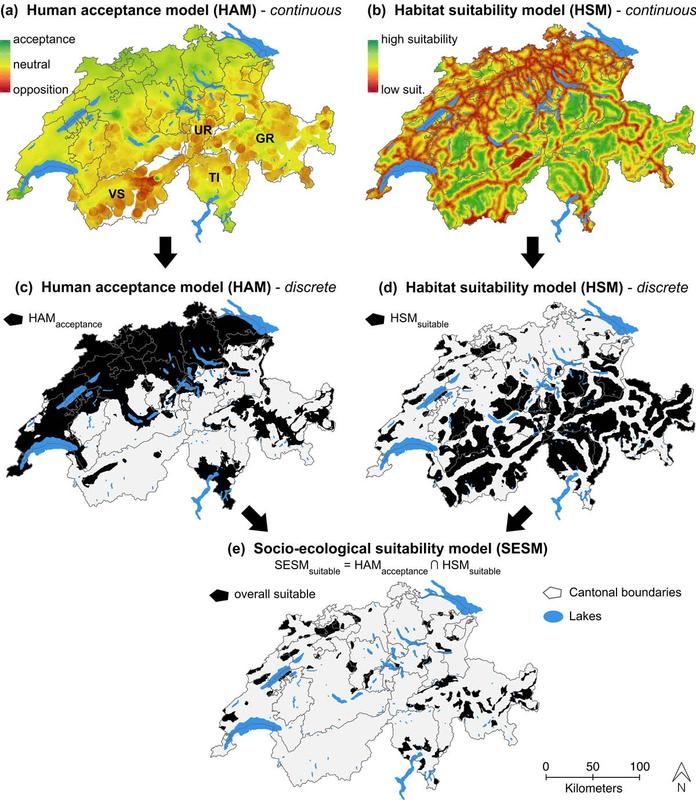A novel socio-ecological approach helps identifying suitable wolf habitats

A human acceptance model and a habitat suitability model graphics: UZH
The wolf was eradicated in Switzerland and from large parts of continental Europe including France and Germany by the end of the 19th century. Following legal protection, the wolf population started naturally increasing and expanding, and in 1995 its presence was confirmed in Switzerland.
Sightings have increased since. Despite 13’800 km2 of Switzerland are characterized by favourable conditions such as large forests with little human pressure and have thus been identified as suitable wolf habitat, wolf expansion in Switzerland has been substantially slower than in other parts of continental Europe.
As the wolf is more and more subject to human-dominated landscapes, scientist at the University of Zurich developed a novel method that integrated both ecological and human components to identify regions with favourable environmental conditions and where the wolf was tolerated.
Mapping human acceptance of the wolf to identify suitable socio-ecological areas
About one third of 10,000 randomly selected residents in Switzerland participated in the survey. Combining the response from questionnaires with geographical information, Dominik Behr and his team created a nationwide map of human acceptance. Acceptance decreased with increasing altitude of residency and even more so where high numbers of sheep and goats were held.
Acceptance increased with increasing distance from confirmed wolf presence and in densely populated areas. People who perceived the wolf as dangerous to humans and harmful to livestock and wildlife mainly opposed the wolf. Younger people, and people who believe that the wolf had a positive influence on the ecosystem had a more positive attitude towards the predator.
“When we overlapped our human acceptance map with a habitat suitability map for the wolf, we realized that only about 6% of Switzerland was characterized by both a positive attitude and favourable environment conditions. This was in contrast to results from the habitat suitability map, which returned one third of the Swiss landscape as being suitable for the wolf” said Dominik Behr.
“As wildlife biologists, we are good at understanding the ecological factors determining the suitability of a habitat for a wildlife species. Due to ever-increasing overlap between human and wildlife, however, we are obliged to take into consideration how human acceptance modifies our ecological description of habitat suitability. This study demonstrates one effective way to do this.” stressed Arpat Ozgul, professor of population ecology at the Department of Evolutionary Biology and Environmental Studies at the University of Zurich, and co-author of the study.
A novel framework to manage wolves and people
The socio-ecological map created by Dominik Behr and his co-authors appears to accurately represent the wolf situation in Switzerland of the past years, including identifications of areas of high, moderate or limited conflict. “By capturing areas characterized by both favourable environmental conditions and a positive acceptance towards the wolf, our approach is a valuable tool to identify overall socio-ecological suitable areas for the wolf.
Under given conditions, those regions are good candidates for the successful short to medium-term expansion of the wolf. Additionally, this approach allows to identify key regions where proactive and targeted socio-ecological management plans and a constructive dialog among different stakeholders are needed” said Dr. Gabriele Cozzi, who coordinated the study.
Literature:
Dominik M. Behr, Arpat Ozgul, Gabriele Cozzi. Combining human acceptance and habitat suitability in a unified socio-ecological suitability model: a case study of the wolf in Switzerland. Journal of Applied Ecology. February 17, 2017. doi 10.1111/1365-2664.12880
Contact:
Dr. Gabriele Cozzi
Department of Evolutionary Biology and Environmental Studies
University of Zurich
Phone +41 44 635 47 56
E-Mail: gabriele.cozzi@ieu.uzh.ch
Media Contact
More Information:
http://www.uzh.ch/All latest news from the category: Life Sciences and Chemistry
Articles and reports from the Life Sciences and chemistry area deal with applied and basic research into modern biology, chemistry and human medicine.
Valuable information can be found on a range of life sciences fields including bacteriology, biochemistry, bionics, bioinformatics, biophysics, biotechnology, genetics, geobotany, human biology, marine biology, microbiology, molecular biology, cellular biology, zoology, bioinorganic chemistry, microchemistry and environmental chemistry.
Newest articles

NASA: Mystery of life’s handedness deepens
The mystery of why life uses molecules with specific orientations has deepened with a NASA-funded discovery that RNA — a key molecule thought to have potentially held the instructions for…

What are the effects of historic lithium mining on water quality?
Study reveals low levels of common contaminants but high levels of other elements in waters associated with an abandoned lithium mine. Lithium ore and mining waste from a historic lithium…

Quantum-inspired design boosts efficiency of heat-to-electricity conversion
Rice engineers take unconventional route to improving thermophotovoltaic systems. Researchers at Rice University have found a new way to improve a key element of thermophotovoltaic (TPV) systems, which convert heat…



